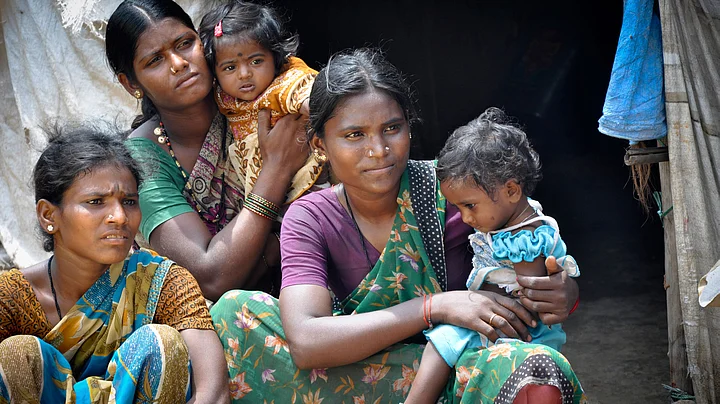It was past 2 p.m. Khusbu Chaudhari, 24, seven months pregnant, was lying on a bed in the general ward at the Ballabhgarh Government Hospital in Haryana’s Faridabad. A thin plastic bag with her medical file lay next to her.
Seven days before, when Chaudhari had first visited the hospital after moving here from her mother’s home in Mumbai, her haemoglobin was 8.2 gm/dL--much below the normal range (12-16 gm/dL) for women. This meant she had moderate anaemia--which, during pregnancy, can be very risky for her and her child.
A health assistant herself, Chaudhari did not want to take chances--she had an emergency caesarean section in 2017 when her first child was born.
Like Chaudhari, more than half of all pregnant women (50.3%) in India were anaemic in 2015-16. Yet, only 30.3% of pregnant women took iron and folic acid tablets for more than 100 days of pregnancy, according to the National Family Health Survey, 2015-16 (NFHS-4).
“It’s not clear yet how well the work on non-nutrition causes (of anaemia) is moving,” Menon said. “And the data on the non-nutritional causes still needs to be released so that a geographically nuanced diagnosis can be done.” The Comprehensive National Nutrition Survey--started in 2016 to evaluate the nutritional status of children and adolescents--is ready, but not yet released.
There is also stronger monitoring with the Anaemia Mukt Bharat dashboard that displays statewise data on availability, and coverage of IFA across different groups. “Every quarter we are relaying the data back to the states so there is [a] continuous monitoring mechanism,” Khera said.
“While dashboards are good to visualise data, we don’t know enough about how the dashboards are being used, who is looking at them, and what kind of actions are being taken,” said Menon of IFPRI. The intended users of the dashboards often need support to walk through the data and understand what actions should be taken, IFPRI research shows.
‘Test-Treat-Talk’ camps
The Test-Treat-Talk (T3) anaemia camp is a key strategy to generate demand and mobilise people. Held across the country since 2018, these camps use a digital hemoglobinometer to test for anaemia, give IFA tablets to treat, and counsel beneficiaries on lifestyle measures to increase iron levels in the body, and on foods rich in iron, protein and vitamin C.
In 2018, 900 camps were conducted nationwide which reached 100,000 people. In March 2019, 196,000 camps were held that reached 16.5 million people. In September 2019, during the nutrition month, T3 camps are expected to be held in government schools, colleges and institutions across India.
“Till now people didn’t know about anaemia or their own haemoglobin level,” said Khera. “This is a way for them to know their levels and also how to correct anaemia with supplements.”
The success of the camps has much to do with the adoption of the digital hemoglobinometer that allows instant haemoglobin testing. Conventionally, using laboratory facilities, it took up to three days for a patient to get their results--which led to poor testing and compliance, said Kapil Yadav, Associate Professor, Community Medicine at the All India Institute of Medical Sciences (AIIMS).
Progress Slow, States Allot a Third of Required Funds
“Since we started administering iron sucrose to pregnant women with anaemia, almost all the women that come for delivery [in the centre] have normal levels of haemoglobin,” said Sunita Malik, 49, nurse-in-charge of the general ward at the hospital. “This means the women have lower risk of haemorrhage during delivery and less need for blood transfusion,” she added. Even lactating mothers are given iron sucrose if they are anaemic, as the baby will receive iron from the mother.
Earlier, only tertiary care centres with specialists were thought to be able to administer intravenous iron. “But our [AIIMS] research has shown iron sucrose is safe to be given in a primary healthcare setting where deliveries occur,” said Yadav, the AIIMS associate professor, adding that in the 12 primary health centres that AIIMS runs, 5,000 infusions of iron sucrose have been given.
“This is especially important given than pregnant women with severe anaemia would then require blood transfusion, which is difficult in a rural setting given paucity of blood banks,” Yadav added.
Back in the Ballabgarh Government Hospital, Chaudhari’s haemoglobin levels will be checked after she receives her third dose of iron sucrose at the end of the month. If she has adequate iron levels, she will need no further intervention. Chaudhari and her unborn child will have adequate iron levels to ward off anaemia for some time to come.
Reporting for this story has been supported by ROSHNI-Centre of Women Collectives Led Social Action.
(Yadavar is a special correspondent with IndiaSpend.)
(This article was originally published on India Spend and has been republished with permission.)
(At The Quint, we question everything. Play an active role in shaping our journalism by becoming a member today.)
